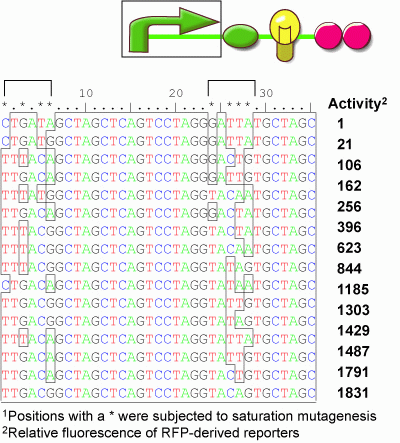Berkeley2006-PromoterMain
From 2006.igem.org
JCAnderson (Talk | contribs) (→) |
JCAnderson (Talk | contribs) (→) |
||
| Line 13: | Line 13: | ||
[[Image:Berkeley2006_Promoter.GIF]] | [[Image:Berkeley2006_Promoter.GIF]] | ||
| - | We therefore developed a set of constitutive promoter parts that vary the transcription rate. The matching of rates can then be achieved by identifying a promoter that satisfies the system's requirements. To make these parts, we adopted a combinatorial approach. A synthetic promoter sequence was targetted with saturation mutagenesis employing a binary swap of the -10 and -35 sequences. Here, 8 positions were simultaneously varied to be either the consensus sequence for that position, or not. We constructed the library fused to an RFP reporter gene containing a strong ribosome binding site, the mRFP1 gene, and a terminator. We inserted the 256 member library into the RFP reporter plasmid and picked 96 visibly white colonies and 96 visibly red colonies. The cells were grown to saturation and then assayed for fluorescence. From this screen, we identified unique promoter variants | + | We therefore developed a set of constitutive promoter parts that vary the transcription rate. The matching of rates can then be achieved by identifying a promoter that satisfies the system's requirements. To make these parts, we adopted a combinatorial approach. A synthetic promoter sequence was targetted with saturation mutagenesis employing a binary swap of the -10 and -35 sequences. Here, 8 positions were simultaneously varied to be either the consensus sequence for that position, or not. We constructed the library fused to an RFP reporter gene containing a strong ribosome binding site, the mRFP1 gene, and a terminator. We inserted the 256 member library into the RFP reporter plasmid and picked 96 visibly white colonies and 96 visibly red colonies. The cells were grown to saturation and then assayed for fluorescence. From this screen, we identified unique promoter variants (parts J23100-J23119) each displaying a different level of activity spanning the physiological range between the level observed with cells containing no mRFP gene and values higher than those observed with a Ptet promoter (r0040). Additionally, we constructed the "consensus" promoter basic part, the strongest constitutive promoter. These parts will find general use in tuning the expression level of Biobrick devices. |
---- | ---- | ||
Next Section: [[Berkeley2006-PlasmidPartsMain | New Biobrick-Compatible Plasmids]] | Next Section: [[Berkeley2006-PlasmidPartsMain | New Biobrick-Compatible Plasmids]] | ||
Latest revision as of 17:17, 30 October 2006
To extend addressable conjugation to a bacterial network, the ability to maintain, send, and receive plasmids must be linked to the transfer of a cognate key sequence in a recipient cell. In this way, whenever a cell recieves a matching key, it becomes activated and responds by sendng a message.
The ability to send messages is linked to the presence of the key by placing critical components of the transfer machinery under lock control. We have identified the traG gene of the R system and the trbC gene of the F system as genes critical for transfer. We deleted these genes and observed no transfer of oriT-containing plasmids. We have contructed Biobrick parts for these genes and are currently constructing locked variants to complement their function.
The ability to maintain a message must similarly be under lock control. Within a network, cells will be constantly receiving messages, and these plasmids will accumulate if allowed to replicate. Our future solution to this problem will employ the R6K/pir system. Here, the protein product of the pir gene is necessary to replicate plasmids with an R6K origin of replication. We will place pir under lock control so that only plasmids containing a cognate key can activate pir and replicate.
Finally, the ability to receive additional messages will be placed under lock control. Various genes, including dnaB are necessary to receive a plasmid by conjugation. We will place these genes similarly under lock control.
Isolatation of a family of constitutive promoter parts from a combinatorial library to vary transcription rates
When placing genes under new regulation, the rates of transcription and translation must be tuned to match the levels necessary for activation of the device. In other words, too much protein in the "off" state can lead to a situation where the observed phenotype occurs independently of the key. Similarly, too little protein in the "on" state can result in a scenario where the bacteria do not conjugate even when the key is present. When controlling a gene transcriptionally, this matching of rates can be achieved by manipulating the ribosome binding site of the gene. In translation control, however, the sequence of the ribosome binding site is an essential feature of the mode of regulation and cannot be changed independently. In this scenario, the transcription rate of the device must instead be changed.
We therefore developed a set of constitutive promoter parts that vary the transcription rate. The matching of rates can then be achieved by identifying a promoter that satisfies the system's requirements. To make these parts, we adopted a combinatorial approach. A synthetic promoter sequence was targetted with saturation mutagenesis employing a binary swap of the -10 and -35 sequences. Here, 8 positions were simultaneously varied to be either the consensus sequence for that position, or not. We constructed the library fused to an RFP reporter gene containing a strong ribosome binding site, the mRFP1 gene, and a terminator. We inserted the 256 member library into the RFP reporter plasmid and picked 96 visibly white colonies and 96 visibly red colonies. The cells were grown to saturation and then assayed for fluorescence. From this screen, we identified unique promoter variants (parts J23100-J23119) each displaying a different level of activity spanning the physiological range between the level observed with cells containing no mRFP gene and values higher than those observed with a Ptet promoter (r0040). Additionally, we constructed the "consensus" promoter basic part, the strongest constitutive promoter. These parts will find general use in tuning the expression level of Biobrick devices.
Next Section: New Biobrick-Compatible Plasmids

